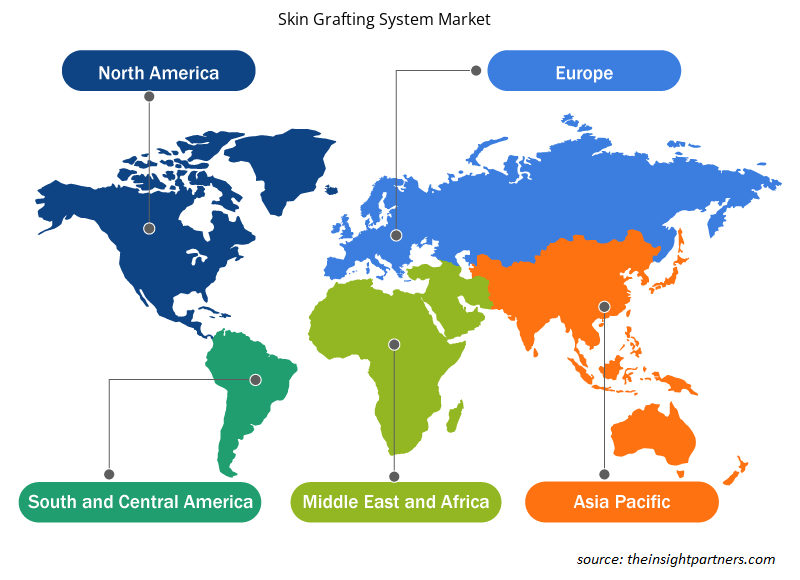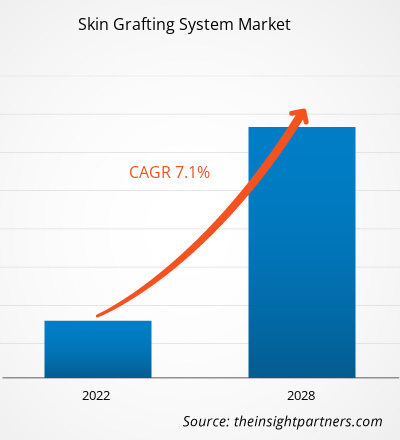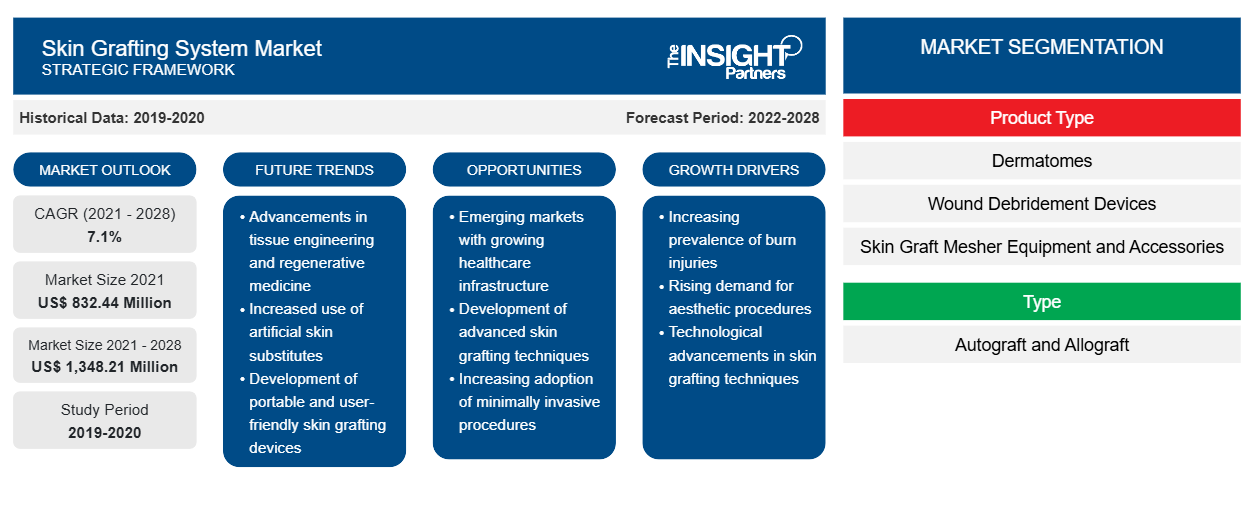Se proyecta que el mercado de sistemas de injerto de piel alcance los US$ 1.348,21 millones para 2028 desde los US$ 832,44 millones en 2021; se estima que crecerá a una CAGR del 7,1% durante 2021-2028.
Los sistemas de injerto de piel son una serie de dispositivos, equipos, instrumentos y consumibles que se utilizan en el proceso de injerto de piel, como la recolección de muestras, la formación de la malla y el injerto final. Algunos pasos incluidos en el proceso de injerto de piel consisten en la recolección de injerto de piel (usando dermatomo), la malla de piel (usando equipo de malla de piel y accesorios), el desbridamiento de la herida (usando dispositivos de desbridamiento de heridas) y todos los consumibles e instrumentos relacionados en el proceso de injerto de piel. El injerto de piel se realiza en varios tipos de heridas, como quemaduras, heridas crónicas, heridas traumáticas y heridas quirúrgicas. Los injertos de piel promueven el proceso de curación en casos en los que el proceso de curación puede ser extremadamente lento o insignificante.
El mercado de sistemas de injerto de piel está segmentado en función del tipo de producto, tipo, tipo de herida, usuario final y geografía. El mercado, por geografía, está ampliamente segmentado en América del Norte, Europa, Asia Pacífico, Oriente Medio y África, y América del Sur y Central. El informe de mercado de sistemas de injerto de piel ofrece información y un análisis profundo del mercado, haciendo hincapié en parámetros como el tamaño del mercado, las tendencias y la dinámica; los avances tecnológicos en el mercado; y el análisis del panorama competitivo de los principales actores del mercado de sistemas de injerto de piel.
Personalice este informe según sus necesidades
Obtendrá personalización en cualquier informe, sin cargo, incluidas partes de este informe o análisis a nivel de país, paquete de datos de Excel, así como también grandes ofertas y descuentos para empresas emergentes y universidades.
- Obtenga las principales tendencias clave del mercado de este informe.Esta muestra GRATUITA incluirá análisis de datos, desde tendencias del mercado hasta estimaciones y pronósticos.
Se espera que algunos factores, como el aumento de los casos de quemaduras, la creciente prevalencia del cáncer de piel y la diabetes, y la creciente variedad de fuentes de injerto de piel para el sistema de injerto, tengan un impacto significativo a corto, mediano y largo plazo en el mercado de sistemas de injerto de piel en los próximos años. Sin embargo, el costo de los procedimientos de injerto de piel obstaculiza el crecimiento del mercado. El informe de mercado identifica oportunidades y tendencias futuras del mercado que pueden tener posibles impactos en el crecimiento del mercado.
Perspectivas de mercado:
aumento de casos de lesiones por quemaduras
Las principales áreas de aplicación de los injertos de piel son las quemaduras y las infecciones cutáneas. Ha habido un aumento en el número de muertes causadas por quemaduras. Según la Asociación Estadounidense de Quemaduras, en 2016, en los EE. UU., hubo 3390 muertes de civiles debido a incendios, incluidas 2800 muertes por incendios de estructuras residenciales, 150 muertes por incendios de estructuras no residenciales, 355 por incendios de vehículos y 85 por incendios externos y no clasificados que no sean incendios de estructuras o vehículos. Las estadísticas incluyeron más de 14 650 lesiones. Las estadísticas han demostrado que hubo 58 520 lesiones entre los bomberos de los EE. UU. en servicio entre 2011 y 2018. La Asociación Nacional de Protección contra Incendios (NFPA) estimó que se produjeron 1 388 500 incendios en 2020, que causaron 3500 muertes de civiles y 15 200 lesiones. La NFPA descubrió que, si bien el número de muertes relacionadas con incendios disminuyó en un 46 % desde 1980, hubo un aumento del 23 % desde el número récord de muertes en 2012, que se situó en 2855, hasta la cifra actual. Los hallazgos de la NFPA también concluyeron que los incendios en viviendas unifamiliares y bifamiliares representaron el 63,7 % de las víctimas civiles y el 56,6 % de las lesiones, seguidos de los incendios en apartamentos, que representaron el 19,1 % de las lesiones en 2020.NFPA) estimated that 1,388,500 fires took place in 2020, which caused 3,500 civilian deaths and 15,200 injuries. The NFPA found that while the number of fire-related deaths declined by 46% since 1980, there was an increase of 23% from the record low number of deaths in 2012, which stood at 2,855 to the present figure. The NFPA findings also concluded that one-and two-family home fire accounted for 63.7% of civilian casualties and 56.6% of injuries, followed by apartment fires which stood at 19.1% of injuries in 2020.
De manera similar, según las estadísticas de la Organización Mundial de la Salud (OMS) publicadas en 2018, más de 180.000 personas murieron en todo el mundo debido a quemaduras. La mayoría de las quemaduras se notifican en países de ingresos bajos o medios de África y el sudeste asiático. Por ejemplo, la OMS estima que un millón de personas en la India sufren quemaduras moderadas o graves cada año. De manera similar, en Bangladesh, Colombia, Egipto y Pakistán, el 17% de las quemaduras en niños provocan discapacidades temporales, mientras que el 18% tienen una discapacidad permanente. Con el aumento del número de lesiones por quemaduras, la demanda de injertos de piel para reemplazar el parche de piel dañado aumentó en los últimos años. Según las estadísticas del National Burn Repository (NBR), en 2016, alrededor de 486.000 lesiones por quemaduras recibieron tratamiento médico. Más del 60% de las hospitalizaciones relacionadas con lesiones por quemaduras se admitieron en 128 centros de quemados. Además, el costo del tratamiento aumentó en todo el mundo. Por ejemplo, en 2017, el Servicio Nacional de Salud (NHS) del Reino Unido trató a unos 15.000 pacientes con quemaduras, y el coste del tratamiento fue de más de 24,94 millones de dólares (es decir, 20 millones de libras esterlinas). De manera similar, en los Estados Unidos, cada año se gastan más de 7.900 millones de dólares en visitas a urgencias y atención hospitalaria de quemaduras.NBR) statistics, in 2016, around 486,000 burn injuries received medical treatment. Over 60% of the hospitalizations related to burn injuries were admitted to 128 burn centers. Also, the cost of treatment increased worldwide. For instance, in 2017, the National Health Services (NHS), UK, treated ~15,000 patients with burn injuries, and the cost of treatment was over US$ 24.94 million (i.e., GBP 20 million). Similarly, in the US, every year, more than US$ 7.9 billion is spent on emergency room visits, and hospital burn cares.
Además, el creciente número de lesiones por quemaduras está impulsando a los sistemas de atención sanitaria a implementar programas de atención y servicios de gestión de quemaduras. Además, Arabia Saudita implementó un programa de atención de quemaduras en virtud del cual se distribuyen 17 instalaciones de atención de quemaduras en todo el país. Las organizaciones del país están aplicando activamente el tratamiento de quemaduras para mejorar el injerto de piel. Por ejemplo, los servicios de atención de quemaduras de la Unidad de Quemados y el Departamento de Cirugía Plástica de la Ciudad Médica Militar Príncipe Sultán (PSMMC) incluyen un programa de injerto de piel y rehabilitación a largo plazo. Por lo tanto, el creciente número de lesiones está contribuyendo significativamente a la creciente demanda de tratamientos de injerto de piel, lo que aumenta el crecimiento del mercado.PSMMC) burn care services include a skin grafting program and long-term rehabilitation. Thus, the increasing number of injuries is contributing significantly to the growing demand for skin graft treatments, thereby increasing the market growth.
Información basada en el tipo de producto
El mercado global de sistemas de injerto de piel, según el tipo de producto, está segmentado en dermatomas, dispositivos de desbridamiento de heridas , equipos y accesorios para mallas de injertos de piel, entre otros. Se espera que el segmento de dispositivos de desbridamiento de heridas tenga la mayor participación del mercado en los próximos años. Sin embargo, se espera que el segmento de dermatomas registre la CAGR más alta durante el período de pronóstico. El mercado del segmento de dermatomas se segmenta aún más en dermatomas eléctricos, dermatomas de tambor y otros. Además, el mercado del segmento de equipos y accesorios para mallas de piel se subsegmenta en cortadores de mallas, portadores de mallas y otros productos complementarios.dermatomes, mesher equipment and accessories, and others. The wound debridement devices segment is expected to hold the largest share of the market in the coming years. However, the dermatomes segment is expected to register the highest CAGR during the forecast period. The market for the dermatomes segment is further segmented into electric dermatomes, drum dermatomes, and others. Also, the market for the skin mesher equipment and accessories segment is subsegmented into mesher cutters, mesher carriers, and other companion products.
Perspectivas basadas en tipos
Según el tipo, el mercado de sistemas de injerto de piel se segmenta en autoinjerto y aloinjerto. El segmento de autoinjerto tuvo una mayor participación en el mercado en 2021 y se espera que tenga una participación significativa en el mercado durante el período de pronóstico. Sin embargo, se espera que el segmento de aloinjerto registre una CAGR más alta de 2021 a 2028.autograft and allograft. The autograft segment held a larger share of the market in 2021 and is expected to hold a significant share of the market during the forecast period. However, the allograft segment is expected to register a higher CAGR from 2021 to 2028.
Información basada en el tipo de herida
Según el tipo de herida, el mercado de sistemas de injerto de piel se segmenta en quemaduras, heridas crónicas, heridas traumáticas, heridas quirúrgicas y otras. Se espera que el segmento de quemaduras tenga la mayor participación del mercado durante el período de pronóstico. Sin embargo, se espera que el segmento de heridas quirúrgicas registre la CAGR más alta durante 2021-2028.
Información basada en el usuario final
Según el usuario final, el mercado de sistemas de injerto de piel está segmentado en hospitales, centros quirúrgicos ambulatorios y clínicas especializadas. El segmento de hospitales tuvo la mayor participación del mercado y se espera que registre la CAGR más alta durante el período de pronóstico.
Varias empresas que operan en el mercado de sistemas de injerto de piel adoptan estrategias como lanzamientos de productos, fusiones y adquisiciones, colaboraciones, innovaciones de productos y expansiones de carteras de productos para expandir su presencia en todo el mundo, mantener una marca y satisfacer las crecientes demandas de los consumidores.
Perspectivas regionales del mercado de sistemas de injerto de piel
Los analistas de Insight Partners explicaron en detalle las tendencias y los factores regionales que influyen en el mercado de sistemas de injerto de piel durante el período de pronóstico. Esta sección también analiza los segmentos y la geografía del mercado de sistemas de injerto de piel en América del Norte, Europa, Asia Pacífico, Oriente Medio y África, y América del Sur y Central.

- Obtenga datos regionales específicos para el mercado de sistemas de injerto de piel
Alcance del informe de mercado del sistema de injerto de piel
| Atributo del informe | Detalles |
|---|---|
| Tamaño del mercado en 2021 | US$ 832,44 millones |
| Tamaño del mercado en 2028 | US$ 1.348,21 millones |
| CAGR global (2021-2028) | 7,1% |
| Datos históricos | 2019-2020 |
| Período de pronóstico | 2022-2028 |
| Segmentos cubiertos | Por tipo de producto
|
| Regiones y países cubiertos | América del norte
|
| Líderes del mercado y perfiles de empresas clave |
|
Densidad de actores del mercado de sistemas de injerto de piel: comprensión de su impacto en la dinámica empresarial
El mercado de sistemas de injerto de piel está creciendo rápidamente, impulsado por la creciente demanda de los usuarios finales debido a factores como la evolución de las preferencias de los consumidores, los avances tecnológicos y una mayor conciencia de los beneficios del producto. A medida que aumenta la demanda, las empresas amplían sus ofertas, innovan para satisfacer las necesidades de los consumidores y aprovechan las tendencias emergentes, lo que impulsa aún más el crecimiento del mercado.
La densidad de actores del mercado se refiere a la distribución de las empresas o firmas que operan dentro de un mercado o industria en particular. Indica cuántos competidores (actores del mercado) están presentes en un espacio de mercado determinado en relación con su tamaño o valor total de mercado.
Las principales empresas que operan en el mercado de sistemas de injerto de piel son:
- Biomet de Zimmer
- B. Braun Medicina
- Exsurco Medical, Inc.
- Instrumentos quirúrgicos Aygun Co., Inc.
- De Soutter Medical
Descargo de responsabilidad : Las empresas enumeradas anteriormente no están clasificadas en ningún orden particular.

- Obtenga una descripción general de los principales actores clave del mercado de sistemas de injerto de piel
Perfiles de empresas
- Biomet de Zimmer
- B. Braun Medicina
- Exsurco Medical, Inc.
- Instrumentos quirúrgicos Aygun Co., Inc.
- De Soutter Medical
- Lutz GmbH & Co. KG
- Smith y sobrino
- Compañía Corp. Stryker.
- Integra Lifesciences Holdings Corp.
- Humeca BV
- Análisis histórico (2 años), año base, pronóstico (7 años) con CAGR
- Análisis PEST y FODA
- Tamaño del mercado, valor/volumen: global, regional y nacional
- Industria y panorama competitivo
- Conjunto de datos de Excel
Informes recientes
Testimonios
Razón para comprar
- Toma de decisiones informada
- Comprensión de la dinámica del mercado
- Análisis competitivo
- Información sobre clientes
- Pronósticos del mercado
- Mitigación de riesgos
- Planificación estratégica
- Justificación de la inversión
- Identificación de mercados emergentes
- Mejora de las estrategias de marketing
- Impulso de la eficiencia operativa
- Alineación con las tendencias regulatorias























 Obtenga una muestra gratuita para - Mercado de sistemas de injerto de piel
Obtenga una muestra gratuita para - Mercado de sistemas de injerto de piel